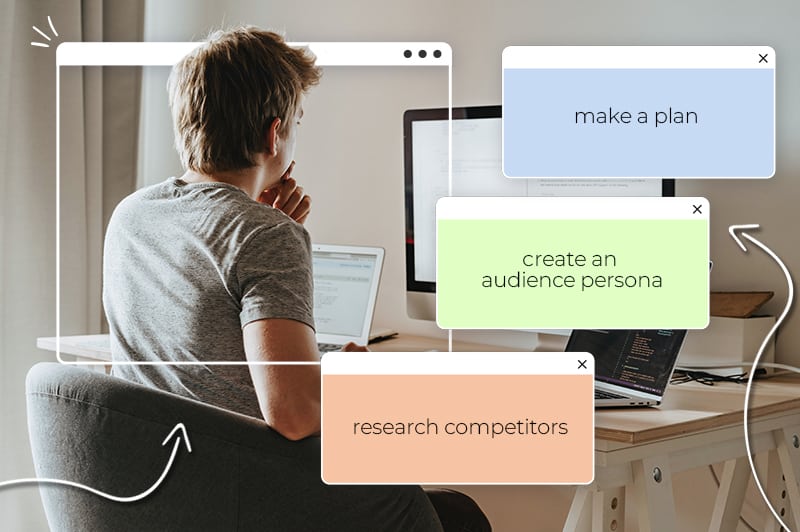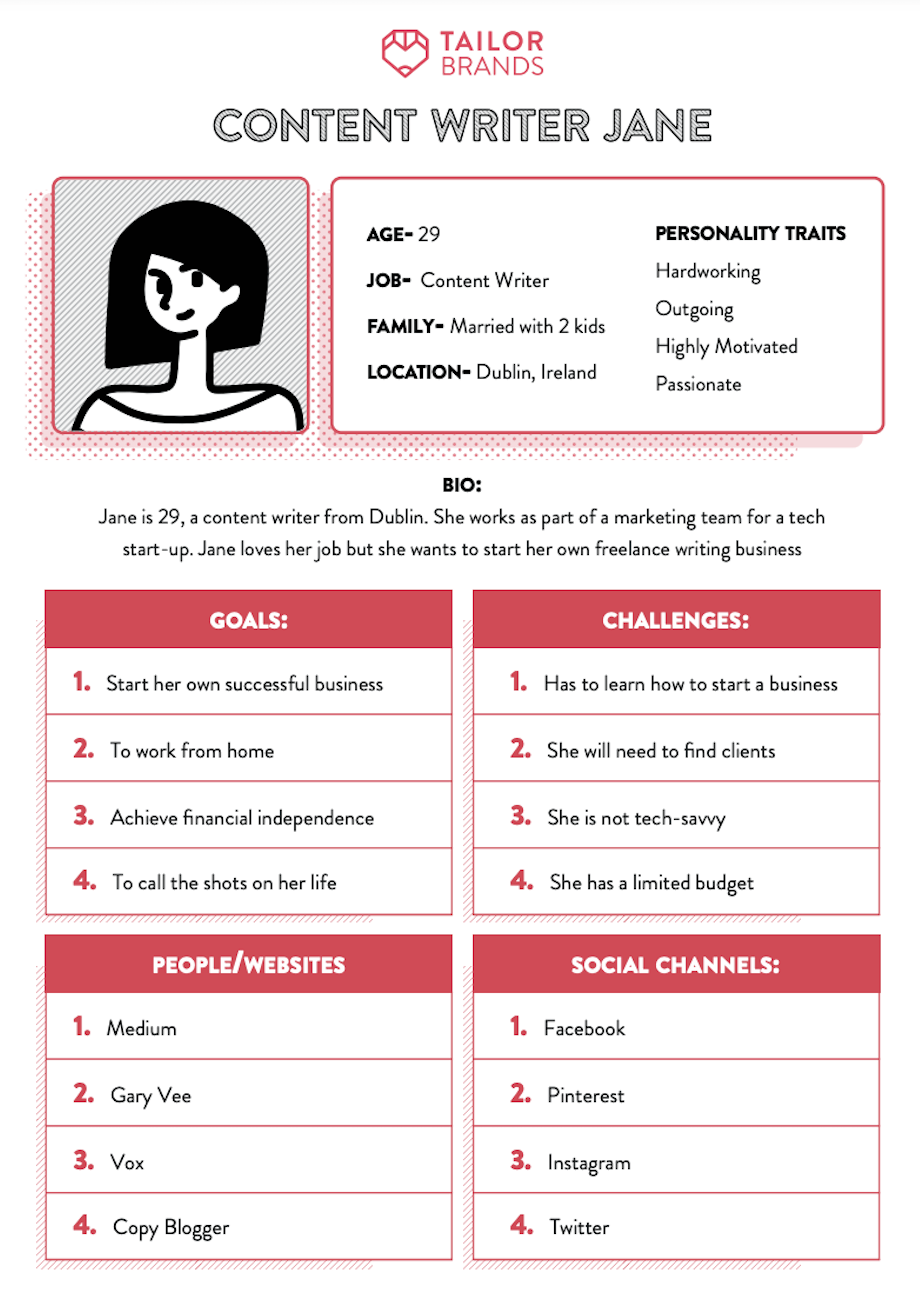
Every post and video all tell you the same thing: when building a business, you need to know your audience. Audience research is one of the most important elements to understand if you want your business to succeed. But why?
The answer is simple. If you don’t know your audience, how will you tell them what they want to hear and give them what they want?
When you know your audience, you understand their needs. And when you know their needs, you know how to market your product or service to them. This is where audience research comes in.
But how can you know your audience if you don’t have one yet? If you’re struggling to research your audience, you’ve come to the right place.
In this post, I’m going to teach you how to research and discover your audience when you don’t have one. So let’s get started.

I don’t want to complicate things that aren’t complicated, to begin with. When you want to find out about your audience, you do research. That’s exactly what audience research is.
It’s the research of a group of people you want to sell to and attract. To do this, you research and collect information to understand who they are— their pain points, needs, and behaviors.
But don’t you need an audience to research? No, you don’t.
While you were googling and trying to figure out how to research your audience, you probably came across other terms like “market research” or “target audience.” Confusing, I know.
But don’t get too stuck on these terms. As you’ll see, in the end, these terms all point to knowing your audience.
Market research is learning whether your product or service has an audience. Let’s say you have a small business selling candles (who doesn’t like candles?).
Market research would consist of you understanding the candle industry, product volume, and the general profits. That’s market research.
Audience research is when you research to find a group of people to sell to. This group of people is called a target market.
Your target market is a group of people that could be your potential audience. So, for example, say you have a business selling candles, after doing audience research, you see that women between 20 to 35 are interested in buying candles. They are your target market.
The audience persona (also known as buyer’s persona) is a detailed description of a person representing your audience. The person is fictional but mirrors your ideal audience.
After getting information about your audience, you create a persona to help you understand their needs, behaviors, and motivations. Don’t worry, I’ll go into detail about it later on—it’s an important part of audience research.
Of course, you’ll want even more information about your target market. With more research, your audience persona (which I’ll be talking about later on), and testing out different ads on social media, you find out more info about the people who buy candles.
You see that women between 20 and 35 who are single, with a university degree, and love reading purchase candles. This would be your target audience. A target audience is a specific group of people who are very likely to buy your product.

The main difference between a successful business and an unsuccessful business is what they know about their audience—it’s the bread and butter of any business.
Aligning your message with your audience is your key to success. But there are a couple of other reasons why audience research matters.
I already mentioned it, but I need to say it again because it’s important. As a business owner, you need to know your audience.
When you know your audience, you can better connect with them and grow your business. So, instead of focusing on your product, focus on your audience—they’ll tell you how to improve your business.
What should you focus on first when building a business? You’re the owner, so it’s in your hands!
Audience research helps you decide what you should be focusing on and how to meet the needs of your audience.
When you know your audience, you can make better decisions for your business.
Let’s say you don’t think weighted blankets are appealing for women under 25-years-old, this is your assumption. But are you right?
Understanding your audience can help you either prove or disprove your belief, which will affect how you communicate with your audience.
Before I go ahead and tell you how to get started with audience research, stop for a moment and think if you really don’t have an audience. Because I have a feeling you may have one.
Do you have friends? Family? A social media following (big or small)? If you said yes to any of the above, you have an audience.
Sometimes we feel we need to have a huge following of people to understand our audience, but our friends and family are consumers too. Are they your ideal audience? Maybe not, but that’s also useful information to know.
If you want, make a Google Form and ask them a few questions, like the following:
You may find out helpful information to get you started with your audience research. Of course, you still need to conduct audience research (there’s no escaping it, sorry #notsorry).
After reading the above you may be thinking, “well, isn’t everyone in my target audience?” No.
I know you want to take the easy way out (who doesn’t?), but everyone (including you) is not in your target audience. And there are some valuable reasons why.
Your product or service should connect to a specific audience. If it doesn’t connect with anyone, you need to take a second look at your business.
But that’s probably not the case. Your product appeals to a specific audience, and with research, you’ll find out who that audience is.
Here’s the thing, I know you want everyone to love your product or service, but that’s not going to happen. Not everyone is going to be interested, and that’s okay.
Even if your audience loves your product, not all of them will connect with your marketing message.
People buy things for different reasons. This is why you’ll need to have different marketing messages to connect with the varying needs of your buyers.
Are you sure you want to target everyone as your audience?
Spending your marketing budget on people who aren’t interested in your product or service will drain your marketing budget (and you won’t see that money back).
By knowing your target audience, you can put your marketing budget into people who have a high chance of making a sale.

Researching your audience can help you discover your ideal customer—and that’s exactly what you want.
By knowing your audience, you can market your business to a group of people who are more likely to purchase from you. But where do you start? Here’s how you can conduct audience research.
What’s step one? It can seem a little overwhelming at first, so this is why you should create a plan.
Firstly, answer the questions below to help build a base for your audience research.
With these questions answered, you have a clear idea of your brand and what you’re seeking to understand about your audience.
You may not know your audience, but your competitors do. When you don’t have an audience of your own, looking at your competition can provide you with information on who is purchasing your product.
When researching, go deep—think of yourself as a detective. Go on your competitor’s websites and their social media profiles—explore their audience, check out the profiles of their customers and see if you can get any helpful information.
Software like Ubersuggest can help you with even more information on your competitors. The more, the merrier.
After you’ve explored your competitors and got all the information you could find, you’ll have a rough idea of your target audience.
But how do you connect with them on a personal level? This is when you create an audience persona (also known as a buyer’s persona).
For this, you should create an audience persona. You remember my example of Sarah from earlier on, right? Let me refresh your memory.
The example was that you opened a business selling candles. Before you can market your candles to your audience, you need to know who your audience is (their struggles, daily habits, and goals). That’s where an audience persona comes into play.
So how do you create an audience persona? Here’s what you include:
Now with this information, we write a story about her. Here’s the audience persona of Sarah, your ideal audience for your candle business.
Sarah is 28-years-old, she graduated university with a bachelor’s degree in psychology and is now working in HR at a local hospital in Boston. Sarah isn’t married, she’s single at the moment and rents a small apartment on her own.
She loves her job, but it’s stressful and exhausting, so when she comes home, she wants it to be her sanctuary – a peaceful and calm space. After a long day at work, she enjoys taking a bath, and then curling up on the couch with a glass of wine and a good book.
Is Sarah an actual person? No, but she could be. She’s a made-up character that shows your audience’s behavior, goals, challenges, demographics, and interests.
From the persona of Sarah, you see deeper into who Sarah (ie. your audience) is and what pain points you need to connect with.
Once you create an audience persona, you have a clearer idea of your target audience and how you can connect with them on a personal level.


Download this PDF template and have it available whenever you need.
What is the motivation behind buying your product or service? Why do they want to buy your product? This is the question you want to answer, and you probably will when creating the audience persona—understanding the “why” behind a customer’s purchase is a huge advantage.
Once you understand their needs, you can create specific marketing campaigns and improve your product/service to fit your customers’ needs.
But remember, there are multiple reasons why someone would purchase your product.
For example, some people buy candles to reduce stress and anxiety, others buy them to create an intimate environment to spice up their relationship. But by understanding the different reasons why, you can create multiple marketing campaigns.
You created an audience persona that reflects your ideal customer. But not everyone will match that persona (which is normal, so don’t worry). If there’s something you want to know about your audience, ask them.
Yes, you may not have an audience, but as I said before, you do probably have some people around you (friends, family) that may be your audience.
After developing your audience persona, create some marketing campaigns and take a look at the data—what is it telling you?
Who are the people that are looking at your website? Are you engaging with the right audience, or do you need to make some changes?
Discovering your audience isn’t something that’s going to happen overnight. It’ll take some time for you to find out who your audience really is.
What’s important is not to hold onto any beliefs of who you think they are. Suppose you notice your demographic change; Go with the flow.
As your business grows, you’ll have to periodically check your audience (monthly, quarterly, or annually) to see if your audience has changed.
We’ve covered how to conduct audience research (when you have no audience) and the steps needed to take. Now, it’s up to you to put them into action.
Just remember, researching your audience takes time, so be patient and kind to yourself. No one said this was easy!
This portion of our website is for informational or educational purposes only. Tailor Brands is not a law firm, and the information on this website does not constitute legal advice. All statements, opinions, recommendations, and conclusions are solely the expression of the author and provided on an as-is basis. Accordingly, Tailor Brands is not responsible for the information and/or its accuracy or completeness. It also does not indicate any affiliation between Tailor Brands and any other brands, services or logos on this page.
Products
Resources
©2025 Copyright Tailor Brands